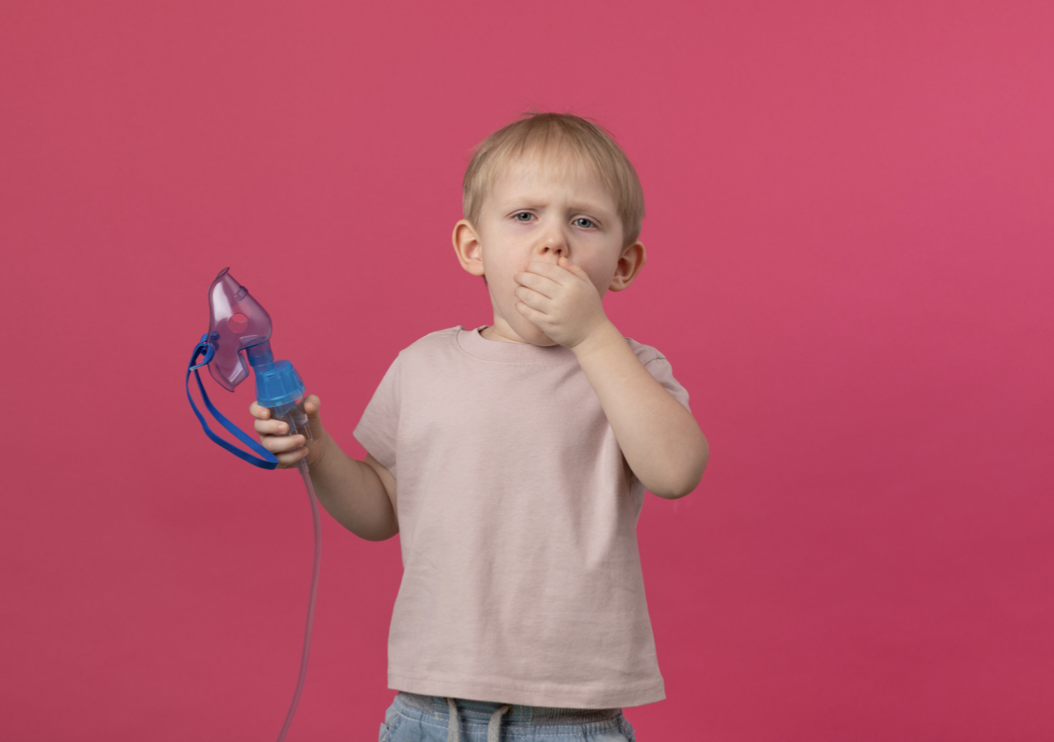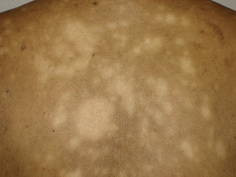Definisi
Bronkiolitis adalah peradangan saluran napas yang terjadi secara mendadak dan cepat, berupa tersumbatnya salah satu bagian saluran napas bagian bawah yaitu bronkiolus akibat infeksi. Bronkiolitis sering disebabkan oleh virus dan menyerang bayi serta anak-anak berusia di bawah 2 tahun.
Bronkiolitis merupakan penyebab rawat inap tersering pada bayi berusia di bawah 12 bulan. Sekitar 75.000–125.000 anak yang berusia di bawah 1 tahun di Amerika dirawat akibat bronkiolitis setiap tahunnya.
Penyebab
Sekitar 50% kasus dari bronkiolitis disebabkan oleh infeksi respiratory syncytial virus (RSV) yang sering menyerang saluran pernapasan, diikuti oleh virus parainfluenza dan adenovirus. RSV ini sering menyerang bayi berusia 2 tahun dan sangat mudah menyebar melalui percikan droplet (ketika seseorang batuk, bicara, atau bersin). Virus ini juga bisa menyebar melalui barang yang digunakan bersamaan, seperti handuk, mainan, atau alat makan. Belum ada bukti yang kuat bahwa bakteri dapat menyebabkan bronkiolitis.
Bronkiolitis terjadi ketika bronkiolus (cabang saluran pernapasan yang paling kecil) terinfeksi oleh virus. Infeksi tersebut menyebabkan bronkiolus mengalami peradangan dan membengkak. Proses peradangan menyebabkan produksi mukus (lendir) meningkat, sehingga menyumbat saluran pernapasan, dan membuat udara sulit untuk keluar maupun masuk ke paru. Hal ini dapat menyebabkan udara terperangkap di paru, dan bisa menghalangi proses pertukaran oksigen dan karbon dioksida di dalam paru, sehingga bayi mengalami sesak.
Faktor Risiko
Bronkiolitis umumnya terjadi pada bayi dan anak berusia 2 tahun. Bayi berusia 3 bulan atau kurang memiliki risiko lebih tinggi untuk mengalami bronkiolitis karena paru dan sistem kekebalan tubuhnya yang belum berkembang secara sempurna.
Faktor-faktor yang dapat meningkatkan risiko anak mengalami bronkiolitis berat, antara lain:
- Bayi prematur <30 minggu
- Jenis kelamin laki-laki lebih sering mengalami bronkiolitis (1,7:1)
- Tidak mendapatkan ASI, sekitar 81% bayi kurang gizi dan 72% bayi dengan gizi cukup yang tidak mendapatkan ASI eksklusif mengalami bronkiolitis
- Tinggal di lingkungan padat penduduk
- Ibu berusia muda
- Mengalami kondisi medis lain (penyakit jantung atau paru)
- Mengalami imunodefisiensi (sistem kekebalan tubuh yang lemah)
- Terpapar asap rokok
- Memiliki saudara yang berada di tempat penitipan anak atau bersekolah
Gejala
Pada beberapa hari pertama, tanda dan gejala dari bronkiolitis mirip dengan common cold, infeksi virus yang menyerang hidung dan tenggorokan, yaitu:
- Hidung berair dan pilek
- Hidung tersumbat
- Batuk
- Demam yang tidak terlalu tinggi (tidak selalu ada)
Sekitar beberapa hari hingga satu minggu setelah mengalami gejala tersebut, anak akan mengalami kesulitan bernapas hingga terdengar suara mengi yang seperti siulan nyaring tiap anak bernapas. Anak juga dapat mengalami napas yang merintih, batuk-batuk hingga muntah, rewel, dan penurunan nafsu makan.
Diagnosis
Dokter akan menegakkan diagnosis bronkiolitis secara klinis, dengan mempertimbangkan gejala yang timbul, keluhan utama, faktor risiko anak dan hasil dari pemeriksaan fisik yang dilakukan. Dokter akan bertanya mengenai sejak kapan gejala muncul, gejala sesak yang dialami, riwayat kontak dengan kerabat atau anggota keluarga yang sedang sakit, konsumsi ASI, dan riwayat imunisasi.
Dokter akan memeriksa pernapasan anak untuk melihat bila ada tanda sesak dan turut mendengar suara paru anak. Dokter juga akan memastikan adanya tanda dehidrasi pada anak jika anak mengalami penurunan nafsu makan dan tidak mau minum. Dokter perlu memastikan gejala yang dialami oleh anak merupakan bronkiolitis dan bukan kondisi lain seperti asma, pneumonia atau infeksi yang menimbulkan peradangan pada paru, maupun aspirasi benda asing (benda dari lingkungan masuk ke dalam saluran napas dan menyebabkan gangguan).
Beberapa pemeriksaan tambahan yang dapat dilakukan oleh dokter sesuai indikasi, antara lain:
- X-ray dada untuk mengevaluasi paru anak menggunakan foto polos untuk mengecualikan diagnosis pneumonia. Namun, hal ini jarang dibutuhkan jika anak mengalami bronkiolitis tanpa komplikasi
- Pemeriksaan darah untuk mengonfirmasi adanya infeksi
- Analisis gas darah tidak rutin dilakukan, namun dapat dilakukan jika anak mengalami sesak berat
Tata Laksana
Bronkiolitis umumnya berlangsung selama 2–3 minggu dan mengalami perbaikan setelahnya. Umumnya anak dapat dirawat di rumah dan mendapatkan oabt hanya untuk meredakan gejala. Anak yang dirawat di rumah sakit hanya mereka yang memiliki gejala berat atau terdapat komplikasi. Orang tua tetap harus awas dengan adanya perubahan pola napas anak selama perawatan di rumah.
Karena bronkiolitis disebabkan oleh virus, antibiotik tidak memberikan manfaat pada bronkiolitis. Namun, jika anak mengalami infeksi lain seperti infeksi telinga atau pneumonia yang disebabkan oleh bakteri, dan terjadi bersamaan dengan bronkiolitis, dokter dapat memberikan antibiotik. Obat-obatan lain seperti bronkodilator (untuk meredakan gejala penyempitan saluran napas) dan obat kortikosteroid yang memiliki efek anti peradangan, tidak menunjukkan manfaat yang signifikan pada penyakit bronkiolitis.
Jika anak perlu dirawat di rumah sakit karena gejala yang berat, dokter dapat melakukan nebulisasi (terapi dengan obat yang diuapkan) untuk membantu pernapasan anak. Selain itu, anak juga dapat mendapatkan cairan melalui infus jika terdapat tanda dehidrasi atau kekurangan cairan.
Komplikasi
Komplikasi yang dapat timbul dari bronkiolitis berat antara lain:
- Kulit berubah menjadi biru akibat kekurangan oksigen dalam jaringan tubuh
- Napas terhenti (apnea), lebih sering terjadi pada bayi prematur atau bayi yang berusia di bawah dua bulan
- Dehidrasi atau kekurangan cairan
- Gagal napas
Jika hal-hal di atas terjadi, bayi harus segera ditangani di rumah sakit. Pada kasus yang berat, bayi memerlukan bantuan pernapasan menggunakan selang yang dimasukkan ke dalam saluran pernapasan. Bayi yang lahir prematur, memiliki kondisi medis tertentu (kelainan jantung dan paru), atau memiliki sistem kekebalan tubuh yang lemah lebih sering dirawat di rumah sakit akibat bronkiolitis berat.
Pencegahan
Karena virus yang menyebabkan bronkiolitis mudah menyebar, pencegahan yang utama adalah dengan selalu mencuci tangan sebelum menyentuh bayi Anda. Jika Anda sedang flu, gunakan masker setiap berdekatan dengan bayi Anda. Jika bayi Anda mengalami bronkiolitis, jangan bawa bayi Anda keluar rumah untuk sementara waktu agar tidak menyebarkan virus ke orang lain. Saat ini belum ada vaksin khusus untuk mencegah bronkiolitis pada bayi.
Beberapa langkah lainnya yang dapat dilakukan sebagai pencegahan, antara lain:
- Batasi kontak dengan orang yang sedang sakit
Hindari bayi Anda agar tidak terlalu banyak berkontak dengan orang lain untuk mencegah bayi terpapar virus. Hal ini penting terutama jika bayi Anda berusia kurang dari 2 bulan atau lahir prematur.
- Bersihkan lingkungan bayi secara rutin
Membersihkan barang-barang di sekitar bayi seperti mainan dan gagang pintu perlu dilakukan setiap hari, terutama jika ada anggota keluarga lain yang sedang sakit.
- Tutupi hidung dan mulut ketika sedang batuk
Selalu tutup hidung dan mulut Anda ketika batuk dengan siku bagian dalam atau tisu. Segera buang tisu Anda dan cuci tangan sebelum menyentuh bayi.
- Memberi ASI eksklusif
Bronkiolitis lebih jarang terjadi pada bayi yang mendapatkan ASI eksklusif.
Kapan harus ke dokter?
Jika bayi Anda mengalami penurunan nafsu makan dan tidak ingin makan atau minum, bayi Anda terlihat bernapas lebih cepat atau sulit bernapas, segera konsultasikan hal ini dengan dokter anak Anda. Kondisi ini penting untuk disadari dengan cepat, terutama jika anak Anda berusia kurang dari 12 minggu atau memiliki faktor risiko bronkiolitis, seperti bayi lahir prematur dan memiliki kondisi medis lain.
Bronkiolitis jarang menyebabkan bayi terlihat sakit berat. Namun, jika bayi Anda menunjukkan beberapa tanda di bawah ini, segera ke rumah sakit untuk mendapatkan penanganan segera.
- Suara napas bayi terdengar mengi
- Bayi bernapas sangat cepat dan dangkal (lebih dari 60 kali napas per menit)
- Bayi terlihat sulit bernapas (tulang iga anak terlihat tertarik ke dalam ketika menarik napas)
- Terlihat lemas dan apatis
- Tidak mau makan maupun minum
- Kulit anak berubah menjadi biru, terutama di sekitar mulut dan ujung jari
- dr Hanifa Rahma
Justice NA, Le JK. Bronchiolitis. [Updated 2021 Jul 29]. In: StatPearls [Internet]. Treasure Island (FL): StatPearls Publishing; 2022 Jan-. Available from: https://www.ncbi.nlm.nih.gov/books/NBK441959/
National Health Service. (2018). Bronchiolitis. Available from: https://www.nhs.uk/conditions/bronchiolitis/
Palta AK. (2020). Bronchiolitis. KidsHealth. Available from: https://kidshealth.org/en/parents/bronchiolitis.html
Piedra PA. (2018). Bronchiolitis in infants and children: clinical features and diagnosis. Uptodate. Available from: https://www.uptodate.com/contents/bronchiolitis-in-infants-and-children-clinical-features-and-diagnosis?search=bronchiolitis&source=search_result&selectedTitle=2~150&usage_type=default&display_rank=2












